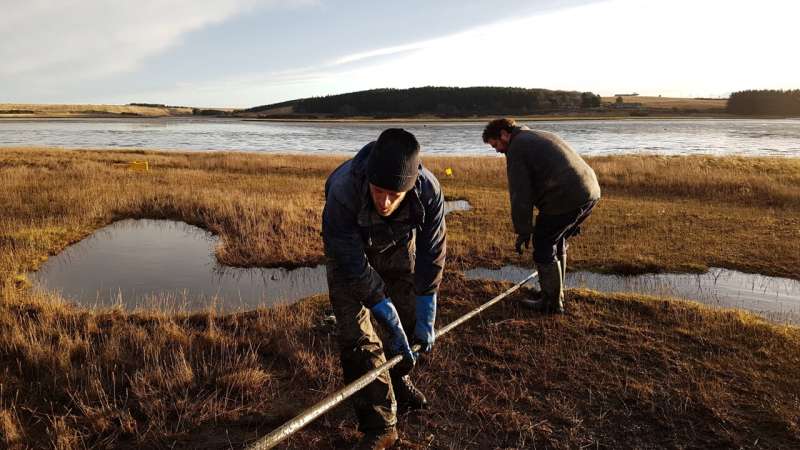This article has been reviewed according to Science X's editorial process and policies. Editors have highlighted the following attributes while ensuring the content's credibility:
fact-checked
trusted source
proofread
Melting ice likely triggered climate change 8,000+ years ago

Using geological samples from the Ythan Estuary in Scotland, scientists have identified a melting ice sheet as the probable trigger of a major climate-change event just over 8,000 years ago.
And the analysis—involving a team of geo-scientists from four Yorkshire universities led by Dr. Graham Rush, who holds positions at both the University of Leeds and Leeds Beckett University—could hold clues as to how present-day ice loss in Greenland could affect the world's climate systems.
More than 8,000 years ago, the North Atlantic and Northern Europe experienced significant cooling because of changes to a major system of ocean currents known as the Atlantic Meridional Overturning Circulation, or AMOC.
The change in AMOC also affected global rainfall patterns.
It is believed that an influx of a massive amount of freshwater into the salt-water seas of the North Atlantic caused the AMOC to breakdown.
The research team took core samples from the sediment in the Ythan Estuary to build up a picture of what was happening to sea levels 8,000-plus years ago.
From analyzing microfossils and the sediment in the samples, they found that sea-level changes departed from normal background fluctuations of around two millimeters a year and reached 13 millimeters a year with individual sea-level events resulting in water rising most likely by about 2 meters in the Ythan Estuary.
The analysis of the core samples provides further evidence that there were at least two major sources of freshwater that drained into the North Atlantic, causing the changes to the AMOC, and not a single source as previously thought.

The view held by many scientists was that the freshwater had come from a giant lake—Lake Agassiz-Ojibway, which was the size of the Black Sea and was situated near what is now northern Ontario -which had drained into the ocean.
Dr. Rush said, "We have shown, that although huge, the lake was not large enough to account for all that water going into the ocean and causing the sea-level rise that we observed."
Instead, Dr. Rush and his colleagues believe the melting of the Hudson Bay Ice Saddle which covered much of eastern Canada and the north-eastern United States provided the injection of vast quantities of water that was reflected in the core samples.
Ocean circulation distributes heat
Heat energy drives the world's climate and the disruption to the ocean current had major ramifications around the world.
Temperatures in the North Atlantic and Europe dropped by between 1.5 and 5 degrees C and lasted for about 200 years, with other regions experienced above average warming. Levels of rainfall also increased in Europe, while other parts of the world, such as parts of Africa, experienced drier conditions and extended periods of drought.
The authors of the study believe the study gives an insight into how current day melting of ice sheets in Greenland may affect global climate systems.
Dr. Rush added, "We know that the AMOC is currently slowing down and, although still debated, some forecasts indicate it could shutdown altogether.
"However, by looking at past events we can learn more about what causes these changes and their likelihood. We have shown that rapid ice-sheet retreat, which may occur in Greenland depending on the path of future fossil fuel emissions, can cause a range of significant climatic effects that would have very worrying consequences."
The findings are published in the journal Quaternary Science Advances.
More information: Graham Rush et al, The magnitude and source of meltwater forcing of the 8.2 ka climate event constrained by relative sea-level data from eastern Scotland, Quaternary Science Advances (2023). DOI: 10.1016/j.qsa.2023.100119
Provided by University of Leeds





















